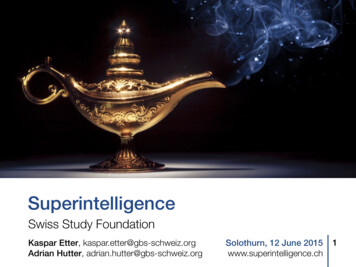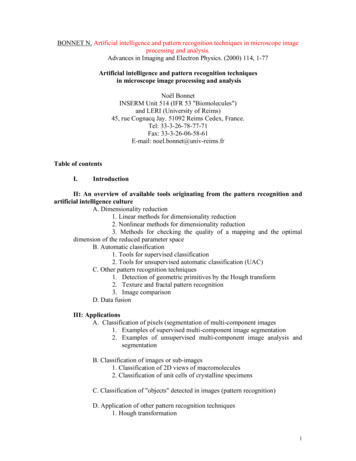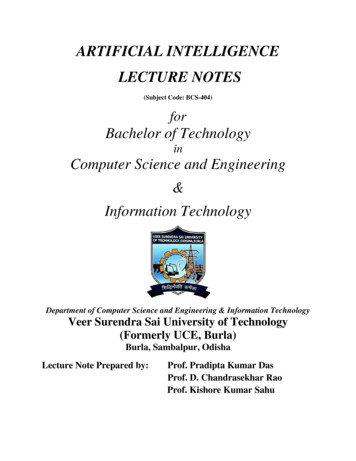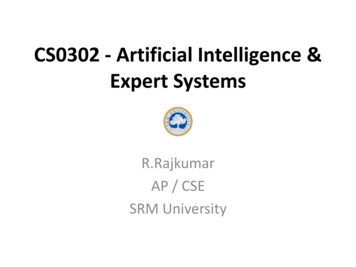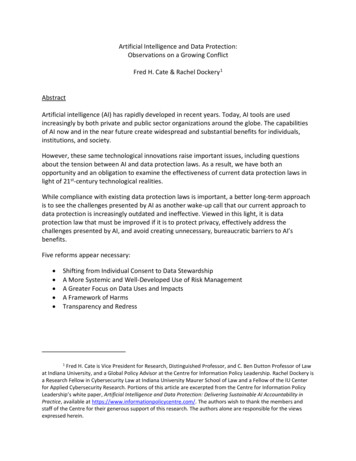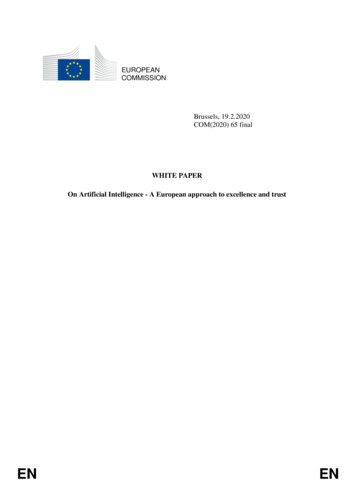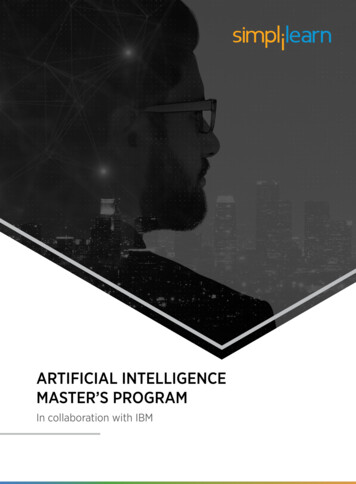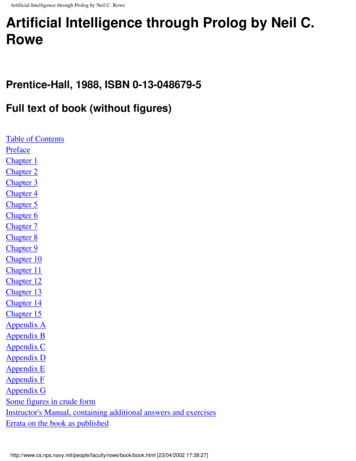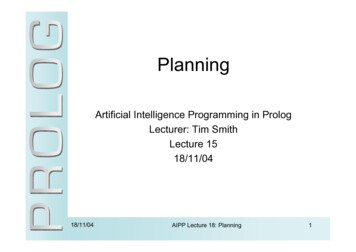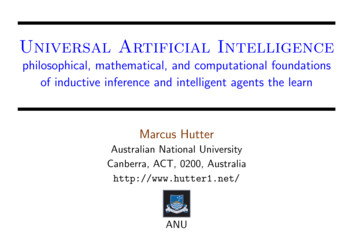
Transcription
Universal Artificial Intelligencephilosophical, mathematical, and computational foundationsof inductive inference and intelligent agents the learnMarcus HutterAustralian National UniversityCanberra, ACT, 0200, Australiahttp://www.hutter1.net/ANU
Universal Artificial Intelligence-2-Marcus HutterAbstract: MotivationThe dream of creating artificial devices that reach or outperform humanintelligence is an old one, however a computationally efficient theory oftrue intelligence has not been found yet, despite considerable efforts inthe last 50 years. Nowadays most research is more modest, focussing onsolving more narrow, specific problems, associated with only someaspects of intelligence, like playing chess or natural language translation,either as a goal in itself or as a bottom-up approach. The dual, topdown approach, is to find a mathematical (not computational) definitionof general intelligence. Note that the AI problem remains non-trivialeven when ignoring computational aspects.
Universal Artificial Intelligence-3-Marcus HutterAbstract: ContentsIn this course we will develop such an elegant mathematicalparameter-free theory of an optimal reinforcement learning agentembedded in an arbitrary unknown environment that possessesessentially all aspects of rational intelligence. Most of the course isdevoted to giving an introduction to the key ingredients of this theory,which are important subjects in their own right: Occam’s razor; Turingmachines; Kolmogorov complexity; probability theory; Solomonoffinduction; Bayesian sequence prediction; minimum description lengthprinciple; agents; sequential decision theory; adaptive control theory;reinforcement learning; Levin search and extensions.
Universal Artificial Intelligence-4-Background and Context Organizational Artificial General Intelligence Natural and Artificial Approaches On Elegant Theories of What is (Artificial) Intelligence? What is Universal Artificial Intelligence? Relevant Research Fields Relation between ML & RL & (U)AI Course HighlightsMarcus Hutter
Universal Artificial Intelligence-5-Marcus HutterOrganizational Suitable for a 1 or 2 semester course:with tutorials, assignments, exam, lab, group project, seminar, .See e.g. [http://cs.anu.edu.au/courses/COMP4620/2010.html] Prescribed texts: Parts of: [Hut05] (theory), [Leg08] (philosophy),[VNH 11] (implementation). Reference details: See end of each section. Main course sources: See end of all slides. For a shorter course: Sections 4.3, 4.4, 5, 6, 7, 10.1, 11might be dropped or shortened. For an even shorter course (4-8 hours):Use [http://www.hutter1.net/ai/suai.pdf]
Universal Artificial Intelligence-6-Marcus HutterArtificial General IntelligenceWhat is (not) the goal of AGI research? Is: Build general-purpose Super-Intelligences. Not: Create AI software solving specific problems. Might ignite a technological Singularity.What is (Artificial) Intelligence?What are we really doing and aiming at? Is it to build systems by trial&error, and if they do somethingwe think is smarter than previous systems, call it success? Is it to try to mimic the behavior of biological organisms?We need (and have!) theories whichcan guide our search for intelligent algorithms.
Universal Artificial Intelligence-7-“Natural” Approachescopy and improve (human) natureBiological Approaches to Super-Intelligence Brain Scan & Simulation Genetic Enhancement Brain AugmentationNot the topic of this courseMarcus Hutter
Universal Artificial Intelligence-8-Marcus Hutter“Artificial” ApproachesDesign from first principles. At best inspired by nature.Artificial Intelligent Systems: Logic/language based: expert/reasoning/proving/cognitive systems. Economics inspired:utility, sequential decisions, game theory. Cybernetics:adaptive dynamic control. Machine Learning:reinforcement learning. Information processing: data compression intelligence.Separately too limited for AGI, but jointly very powerful.Topic of this course: Foundations of “artificial” approaches to AGI
Universal Artificial Intelligence-9-Marcus HutterThere is an Elegant Theory of .Cellular Automata . ComputingIterative maps .Chaos and OrderQED . ChemistrySuper-Strings . the UniverseUniversal AI . Super Intelligence
Universal Artificial Intelligence- 10 -Marcus HutterWhat is (Artificial) Intelligence?Intelligence can have many faces formal definition difficult reasoning creativity association generalization pattern recognition problem solving memorization planning achieving goals learning optimization self-preservation vision language processing motor skills classificationinductiondeduction.What is AI?ThinkingActinghumanlyCognitiveScienceTuring test,BehaviorismrationallyLawsThoughtDoing theRight ThingCollection of 70 Defs of telligence/Real world is nasty: partially unobservable,uncertain, unknown, non-ergodic, reactive,vast, but luckily structured, .
Universal Artificial Intelligence- 11 -Marcus HutterWhat is Universal Artificial Intelligence? Sequential Decision Theory solves the problem of rational agents inuncertain worlds if the environmental probability distribution isknown. Solomonoff’s theory of Universal Inductionsolves the problem of sequence predictionfor unknown prior distribution. Combining both ideas one arrives atA Unified View of Artificial Intelligence Decision Theory Probability Utility Theory Universal Induction Ockham Bayes TuringApproximation and Implementation: Single agent that learns to playTicTacToe/Pacman/Poker/. from scratch.
Universal Artificial Intelligence[http://arxiv.org/abs/0909.0801]- 12 -Marcus Hutter
Universal Artificial Intelligence- 13 -Marcus HutterRelevant Research Fields(Universal) Artificial Intelligence has interconnections with(draws from and contributes to) many research fields: computer science (artificial intelligence, machine learning), engineering (information theory, adaptive control), economics (rational agents, game theory), mathematics (statistics, probability), psychology (behaviorism, motivation, incentives), philosophy (reasoning, induction, knowledge).
Universal Artificial Intelligence- 14 -Marcus HutterRelation between ML & RL & (U)AIUniversal Artificial IntelligenceCovers all Reinforcement Learning problem typesStatisticalMachine LearningMostly i.i.d. dataclassification,regression,clusteringRL Problems& known world /planning problem
Universal Artificial Intelligence- 15 -Marcus HutterCourse Highlights Formal definition of (general rational) Intelligence. Optimal rational agent for arbitrary problems. Philosophical, mathematical, and computational background. Some approximations, implementations, and applications.(learning TicTacToe, PacMan, simplified Poker from scratch) State-of-the-art artificial general intelligence.
Universal Artificial Intelligence- 16 -Marcus HutterTable of Contents1. A SHORT TOUR THROUGH THE COURSE2. INFORMATION THEORY & KOLMOGOROV COMPLEXITY3. BAYESIAN PROBABILITY THEORY4. ALGORITHMIC PROBABILITY & UNIVERSAL INDUCTION5. MINIMUM DESCRIPTION LENGTH6. THE UNIVERSAL SIMILARITY METRIC7. BAYESIAN SEQUENCE PREDICTION8. UNIVERSAL RATIONAL AGENTS9. THEORY OF RATIONAL AGENTS10. APPROXIMATIONS & APPLICATIONS11. DISCUSSION
A Short Tour Through the Course1- 17 -Marcus HutterA SHORT TOUR THROUGH THECOURSE
A Short Tour Through the Course- 18 -Marcus HutterInformal Definition of (Artificial) IntelligenceIntelligence measures an agent’s ability to achieve goalsin a wide range of environments. [S. Legg and M. Hutter]Emergent: Features such as the ability to learn and adapt, or tounderstand, are implicit in the above definition as these capacitiesenable an agent to succeed in a wide range of environments.The science of Artificial Intelligence is concerned with the constructionof intelligent systems/artifacts/agents and their analysis.What next? Substantiate all terms above: agent, ability, utility, goal,success, learn, adapt, environment, . if it is not supported by an experiment Never trust experimenta theorytheory
A Short Tour Through the Course- 19 -Marcus HutterInduction Prediction Decision ActionHaving or acquiring or learning or inducing a model of the environmentan agent interacts with allows the agent to make predictions and utilizethem in its decision process of finding a good next action.Induction infers general models from specific observations/facts/data,usually exhibiting regularities or properties or relations in the latter.ExampleInduction: Find a model of the world economy.Prediction: Use the model for predicting the future stock market.Decision: Decide whether to invest assets in stocks or bonds.Action: Trading large quantities of stocks influences the market.
A Short Tour Through the Course- 20 -Marcus HutterScience Induction Occam’s Razor Grue Emerald Paradox:Hypothesis 1: All emeralds are green.Hypothesis 2: All emeralds found till y2020 are green,thereafter all emeralds are blue. Which hypothesis is more plausible? H1! Justification? Occam’s razor: take simplest hypothesis consistent with data.is the most important principle in machine learning and science. Problem: How to quantify “simplicity”? Beauty? Elegance?Description Length![The Grue problem goes much deeper. This is only half of the story]
A Short Tour Through the Course- 21 -Marcus HutterInformation Theory & Kolmogorov Complexity Quantification/interpretation of Occam’s razor: Shortest description of object is best explanation. Shortest program for a string on a Turing machineT leads to best extrapolation prediction.KT (x) min{ℓ(p) : T (p) x}p Prediction is best for a universal Turing machine U .Kolmogorov-complexity(x) K(x) KU (x) KT (x) cT
A Short Tour Through the Course- 22 -Marcus HutterBayesian Probability TheoryGiven (1): Models P (D Hi ) for probability ofobserving data D, when Hi is true.Given (2): Prior probability over hypotheses P (Hi ).Goal: Posterior probability P (Hi D) of Hi ,after having seen data D.Solution:Bayes’ rule:P (D Hi ) · P (Hi ) P (Hi D) i P (D Hi ) · P (Hi )(1) Models P (D Hi ) usually easy to describe (objective probabilities)(2) But Bayesian prob. theory does not tell us how to choose the priorP (Hi ) (subjective probabilities)
A Short Tour Through the Course- 23 -Marcus HutterAlgorithmic Probability Theory Epicurus: If more than one theory is consistentwith the observations, keep all theories. uniform prior over all Hi ? Refinement with Occam’s razor quantifiedin terms of Kolmogorov complexity:P (Hi ) : 2 KT /U (Hi ) Fixing T we have a complete theory for prediction.Problem: How to choose T . Choosing U we have a universal theory for prediction.Observation: Particular choice of U does not matter much.Problem: Incomputable.
A Short Tour Through the Course- 24 -Marcus HutterInductive Inference & Universal Forecasting Solomonoff combined Occam, Epicurus, Bayes, andTuring into one formal theory of sequential prediction. M (x) probability that a universal Turingmachine outputs x when provided withfair coin flips on the input tape. A posteriori probability of y given x is M (y x) M (xy)/M (x). Given ẋ1 , ., ẋt 1 , the probability of xt is M (xt ẋ1 .ẋt 1 ). Immediate “applications”:- Weather forecasting: xt {sun,rain}.- Stock-market prediction: xt {bear,bull}.- Continuing number sequences in an IQ test: xt N. Optimal universal inductive reasoning system!
A Short Tour Through the Course- 25 -Marcus HutterThe Minimum Description Length Principle Approximation of Solomonoff,since M is incomputable: M (x) 2 KU (x) (quite good) KU (x) KT (x) (very crude) Predict y of highest M (y x) is approximately same as MDL: Predict y of smallest KT (xy).
A Short Tour Through the Course- 26 -Marcus HutterApplication: Universal Clustering Question: When is object x similar to object y? Universal solution: x similar to y x can be easily (re)constructed from y K(x y) : min{ℓ(p) : U (p, y) x} is small. Universal Similarity: Symmetrize&normalize K(x y). Normalized compression distance: Approximate K KU by KT . Practice: For T choose (de)compressor like lzw or gzip or bzip(2). Multiple objects similarity matrix similarity tree. Applications: Completely automatic reconstruction (a) of theevolutionary tree of 24 mammals based on complete mtDNA, and(b) of the classification tree of 52 languages based on thedeclaration of human rights and (c) many others. [Cilibrasi&Vitanyi’05]
A Short Tour Through the Course- 27 -Marcus HutterSequential Decision TheorySetup: For t 1, 2, 3, 4, .Given sequence x1 , x2 , ., xt 1(1) predict/make decision yt ,(2) observe xt ,(3) suffer loss Loss(xt , yt ),(4) t t 1, goto (1)Goal: Minimize expected Loss.Greedy minimization of expected loss is optimal if:Important: Decision yt does not influence env. (future observations).Loss function is known.Problem: Expectation w.r.t. what?Solution: W.r.t. universal distribution M if true distr. is unknown.
A Short Tour Through the Course- 28 -Marcus HutterExample: Weather ForecastingObservation xt X {sunny, rainy}Decision yt Y {umbrella, .01.0Taking umbrella/sunglasses does not influence future weather(ignoring butterfly effect)
A Short Tour Through the Course- 29 -Marcus HutterAgent Modelwith Rewardif actions/decisions ainfluence the environment qr1 o1 r2 o2 r3 o3 r4 o4 r5 o5 r6 o6 worky1AgentpHYHHHHtape .workEnvirontape .ment qPP1 PP PP q Py2y3.y4y5y6.
A Short Tour Through the Course- 30 -Marcus HutterRational Agents in Known Environment Setup: Known deterministic or probabilistic environment Fields: AI planning & sequential decision theory & control theory Greedy maximization of reward r ( Loss) no longer optimal.Example: Chess Agent has to be farsighted. Optimal solution: Maximize future (expected) reward sum,called value. Problem: Things drastically change if environment is unknown
A Short Tour Through the Course- 31 -Marcus HutterRational Agents in Unknown EnvironmentAdditional problem: (probabilistic) environment unknown.Fields: reinforcement learning and adaptive control theoryBig problem: Exploration versus exploitationBayesian approach: Mixture distribution ξ.1. What performance does Bayes-optimal policy imply?It does not necessarily imply self-optimization(Heaven&Hell example).2. Computationally very hard problem.3. Choice of horizon? Immortal agents are lazy.Universal Solomonoff mixture universal agent AIXI.Represents a formal (math., non-comp.) solution to the AI problem?Most (all AI?) problems are easily phrased within AIXI.
A Short Tour Through the Course- 32 -Marcus HutterComputational Issues: Universal Search Levin search: Fastest algorithm forinversion and optimization problems. Theoretical application:Assume somebody found a non-constructiveproof of P NP, then Levin-search is a polynomialtime algorithm for every NP (complete) problem. Practical (OOPS) applications (J. Schmidhuber)Mazes, towers of hanoi, robotics, . FastPrg: The asymptotically fastest and shortest algorithm for allwell-defined problems. Computable Approximations of AIXI:AIXItl and AIξ and MC-AIXI-CTW and ΦMDP. Human Knowledge Compression Prize: (50’000 C)
A Short Tour Through the Course- 33 -Marcus HutterMonte-Carlo AIXI ApplicationsNormalised Average Reward per Cyclewithout providing any domain knowledge, the same agent isable to self-adapt to a diverse range of interactive environments.10.80.60.4[VNH 11]0.2www.youtube.com/watch?v yfsMHtmGDKEExperience0100100010000OptimalCheese MazeTiger4x4 GridTicTacToeBiased RPSKuhn PokerPacman1000001000000
A Short Tour Through the Course- 34 -Discussion at End of Course What has been achieved? Made assumptions. General and personal remarks. Open problems. Philosophical issues.Marcus Hutter
A Short Tour Through the Course- 35 -Marcus HutterExercises1. [C10] What could the probability p that the sun will rise tomorrowbe? What might a philosopher, statistician, physicist, etc. say?2. [C15] Justify Laplace’ rule (p past)n 1n 2 ,where n #days sun rose in3. [C05] Predict ,53,59,?3,1,4,1,5,9,2,6,5,3,?,1,2,3,4,?4. [C10] Argue in (1) and (3) for different continuations.
A Short Tour Through the Course- 36 -Marcus HutterIntroductory Literature[HMU06] J. E. Hopcroft, R. Motwani, and J. D. Ullman. Introduction toAutomata Theory, Language, and Computation. Addison-Wesley,3rd edition, 2006.[RN10]S. J. Russell and P. Norvig. Artificial Intelligence. A ModernApproach. Prentice-Hall, Englewood Cliffs, NJ, 3rd edition, 2010.[LV08]M. Li and P. M. B. Vitányi. An Introduction to KolmogorovComplexity and its Applications. Springer, Berlin, 3rd edition, 2008.[SB98]R. S. Sutton and A. G. Barto. Reinforcement Learning: AnIntroduction. MIT Press, Cambridge, MA, 1998.[Leg08]S. Legg. Machine Super Intelligence. PhD Thesis, Lugano, 2008.[Hut05] M. Hutter. Universal Artificial Intelligence: Sequential Decisionsbased on Algorithmic Probability. Springer, Berlin, 2005.Seehttp://www.hutter1.net/ai/introref.htmfor more.
Information Theory & Kolmogorov Complexity2- 37 -Marcus HutterINFORMATION THEORY &KOLMOGOROV COMPLEXITY Philosophical Issues Definitions & Notation Turing Machines Kolmogorov Complexity Computability Concepts Discussion & Exercises
Information Theory & Kolmogorov Complexity2.1- 38 -Marcus HutterPhilosophical Issues: Contents Induction/Prediction Examples The Need for a Unified Theory On the Foundations of AI and ML Example 1: Probability of Sunrise Tomorrow Example 2: Digits of a Computable Number Example 3: Number Sequences Occam’s Razor to the Rescue Foundations of Induction Sequential/Online Prediction – Setup Dichotomies in AI and ML Induction versus Deduction
Information Theory & Kolmogorov Complexity- 39 -Marcus HutterPhilosophical Issues: AbstractI start by considering the philosophical problems concerning machinelearning in general and induction in particular. I illustrate the problemsand their intuitive solution on various (classical) induction examples.The common principle to their solution is Occam’s simplicity principle.Based on Occam’s and Epicurus’ principle, Bayesian probability theory,and Turing’s universal machine, Solomonoff developed a formal theoryof induction. I describe the sequential/online setup considered in thislecture series and place it into the wider machine learning context.
Information Theory & Kolmogorov Complexity- 40 -Marcus HutterInduction/Prediction ExamplesHypothesis testing/identification: Does treatment X cure cancer?Do observations of white swans confirm that all ravens are black?Model selection: Are planetary orbits circles or ellipses?How many wavelets do I need to describe my picture well?Which genes can predict cancer?Parameter estimation: Bias of my coin. Eccentricity of earth’s orbit.Sequence prediction: Predict weather/stock-quote/. tomorrow,based on past sequence. Continue IQ test sequence like 1,4,9,16,?Classification can be reduced to sequence prediction:Predict whether email is spam.Question: Is there a general & formal & complete & consistent theoryfor induction & prediction?Beyond induction: active/reward learning, fct. optimization, game theory.
Information Theory & Kolmogorov Complexity- 41 -Marcus HutterThe Need for a Unified TheoryWhy do we need or should want a unified theory of induction? Finding new rules for every particular (new) problem is cumbersome. A plurality of theories is prone to disagreement or contradiction. Axiomatization boosted mathematics&logic&deduction and so(should) induction. Provides a convincing story and conceptual tools for outsiders. Automatize induction&science (that’s what machine learning does) By relating it to existing narrow/heuristic/practical approaches wedeepen our understanding of and can improve them. Necessary for resolving philosophical problems. Unified/universal theories are often beautiful gems. There is no convincing argument that the goal is unattainable.
Information Theory & Kolmogorov Complexity- 42 -Marcus HutterOn the Foundations of Artificial Intelligence Example: Algorithm/complexity theory: The goal is to find fastalgorithms solving problems and to show lower bounds on theircomputation time. Everything is rigorously defined: algorithm,Turing machine, problem classes, computation time, . Most disciplines start with an informal way of attacking a subject.With time they get more and more formalized often to a pointwhere they are completely rigorous. Examples: set theory, logicalreasoning, proof theory, probability theory, infinitesimal calculus,energy, temperature, quantum field theory, . Artificial Intelligence: Tries to build and understand systems thatlearn from past data, make good prediction, are able to generalize,act intelligently, . Many terms are only vaguely defined or thereare many alternate definitions.
Information Theory & Kolmogorov Complexity- 43 -Marcus HutterExample 1: Probability of Sunrise TomorrowWhat is the probability p(1 1d ) that the sun will rise tomorrow?(d past # days sun rose, 1 sun rises. 0 sun will not rise) p is undefined, because there has never been an experiment thattested the existence of the sun tomorrow (ref. class problem). The p 1, because the sun rose in all past experiments. p 1 ϵ, where ϵ is the proportion of stars that explode per day. p d 1d 2 ,which is Laplace rule derived from Bayes rule. Derive p from the type, age, size and temperature of the sun, eventhough we never observed another star with those exact properties.Conclusion: We predict that the sun will rise tomorrow with highprobability independent of the justification.
Information Theory & Kolmogorov Complexity- 44 -Marcus HutterExample 2: Digits of a Computable Number Extend 14159265358979323846264338327950288419716939937? Looks random?! Frequency estimate: n length of sequence. ki number ofoccured i Probability of next digit being i is kni .1Asymptotically kni 10(seems to be) true. But we have the strong feeling that (i.e. with high probability) thenext digit will be 5 because the previous digits were the expansionof π. Conclusion: We prefer answer 5, since we see more structure in thesequence than just random digits.
Information Theory & Kolmogorov Complexity- 45 -Marcus HutterExample 3: Number SequencesSequence: x1 , x2 , x3 , x4 , x5 , .1,2,3,4,?, . x5 5, since xi i for i 1.4. x5 29, since xi i4 10i3 35i2 49i 24.Conclusion: We prefer 5, since linear relation involves less arbitraryparameters than 4th-order polynomial.Sequence: 2,3,5,7,11,13,17,19,23,29,31,37,41,43,47,53,59,? 61, since this is the next prime 60, since this is the order of the next simple groupConclusion: We prefer answer 61, since primes are a more familiarconcept than simple groups.On-Line Encyclopedia of Integer Sequences:http://www.research.att.com/ njas/sequences/
Information Theory & Kolmogorov Complexity- 46 -Marcus HutterOccam’s Razor to the Rescue Is there a unique principle which allows us to formally arrive at aprediction which- coincides (always?) with our intuitive guess -or- even better,- which is (in some sense) most likely the best or correct answer? Yes! Occam’s razor: Use the simplest explanation consistent withpast data (and use it for prediction). Works! For examples presented and for many more. Actually Occam’s razor can serve as a foundation of machinelearning in general, and is even a fundamental principle (or maybeeven the mere definition) of science. Problem: Not a formal/mathematical objective principle.What is simple for one may be complicated for another.
Information Theory & Kolmogorov Complexity- 47 -Marcus HutterDichotomies in Artificial Intelligencescope of this course scope of other lectures(machine) learning / statistical logic/knowledge-based (GOFAI)online learning offline/batch learningpassive prediction (re)active learningBayes MDL Expert uninformed / universal informed / problem-specificconceptual/mathematical issues computational issuesexact/principled supervised learning actionFrequentistheuristicunsupervised RL learningexploitation exploration decision prediction induction
Information Theory & Kolmogorov Complexity- 48 -Marcus HutterInduction DeductionApproximate correspondence betweenthe most important concepts in induction and deduction.Induction Deductiongeneralization/prediction specialization/derivationprobability axioms blogical axiomsprior bnon-logical axiomsBayes rule bmodus ponensposterior btheoremsSolomonoff probability bZermelo-Fraenkel set theoryuniversal induction buniversal theorem proverLimitation:incomputable bincomplete (Gödel)In practice:approximations bsemi-formal proofsOperation:computation bproofType of inference:Framework:Assumptions:Inference rule:Results:Universal scheme:Universal inference:The foundations of induction are as solid as those for deduction.
Information Theory & Kolmogorov Complexity2.2- 49 -Marcus HutterDefinitions & Notation: Contents Strings and Natural Numbers Identification of Strings & Natural Numbers Prefix Sets & Codes / Kraft Inequality Pairing Strings Asymptotic Notation
Information Theory & Kolmogorov Complexity- 50 -Strings and Natural Numbers i, k, n, t N {1, 2, 3, .} natural numbers, B {0, 1} binary alphabet, x, y, z B finite binary strings, ω B infinite binary sequences, ϵ for the empty string, 1n the string of n ones, ℓ(x) for the length of string x, xy x y for the concatenation of string x with y. b means ‘corresponds to’. No formal meaning.Marcus Hutter
Information Theory & Kolmogorov Complexity- 51 -Marcus HutterIdentification of Strings & Natural Numbers Every countable set is N (by means of a bijection). Interpret a string as a binary representation of a natural number. Problem: Not unique: 00101 5 101. Use some bijection between natural numbers N and strings B . Problem: Not unique when concatenated, e.g.5 2 10 1 101 1 01 2 4. First-order prefix coding x̄ : 1ℓ(x) 0x. Second-order prefix coding x‘ : ℓ(x)x.[Elias Delta coding]
Information Theory & Kolmogorov Complexity- 52 -Marcus HutterIdentification of Strings & Natural Numbersx N001234567···x B ϵ0100011011000···ℓ(x)01122223···x̄ 1ℓ(x) 0x 0 100101 11000 11001 11010 11011 1110000 · · ·x‘ ℓ(x)x 0 100 0 100 1 101 00 101 01 101 10 101 11 11000 000 · · ·x‘ is longer than x̄ only for x 15, but shorter for all x 30.With this identificationlog(x 1) 1 ℓ(x) log(x 1).ℓ(x̄) 2ℓ(x) 1 2log(x 1) 1 2logxℓ(x‘) log(x 1) 2log(log(x 1) 1) 1 logx 2loglogx[Higher order code: Recursively define ϵ′ : 0 and x′ : 1[ℓ(x) 1]′ x
Information Theory & Kolmogorov Complexity- 53 -Marcus HutterPrefix Sets & CodesString x is (proper) prefix of y: Set P is prefix-free or a prefix code z(̸ ϵ) such that xz y.: no element is a properprefix of another.Example: A self-delimiting code (e.g. P {0, 10, 11}) is prefix-free.Kraft InequalityTheorem 2.1 (Kraft Inequality) For a prefix code P we have x P 2 ℓ(x) 1.Conversely, let ℓ1 , ℓ2 , . be a countable sequence of natural numbers ℓksuch that Kraft’s inequality k 2 1 is satisfied. Then thereexists a prefix code P with these lengths of its binary code.
Information Theory & Kolmogorov Complexity- 54 -Marcus HutterProof of the Kraft-InequalityProof : Assign to each x P the interval Γx : [0.x, 0.x 2 ℓ(x) ).Length of interval Γx is 2 ℓ(x) .Intervals are disjoint, since P is prefix free, hence ℓ(x)2 Length(Γx ) Length([0, 1]) 1x Px PProof idea :Choose l1 , l2 , . in increasing order.Successively chop off intervals of lengths 2 l1 , 2 l2 , .from left to right from [0, 1) anddefine left interval boundary as code.
Information Theory & Kolmogorov Complexity- 55 -Marcus HutterPairing Strings P {x̄ : x B } is a prefix code with ℓ(x̄) 2ℓ(x) 1. P {x‘ : x B } forms an asymptotically shorter prefix code withℓ(x‘) ℓ(x) 2ℓ(ℓ(x)) 1. We pair strings x and y (and z) by ⟨x, y⟩ : x‘y (and⟨x, y, z⟩ : x‘y‘z) which are uniquely decodable, since x‘ and y‘ areprefix. Since ‘ serves as a separator we also write f (x, y) instead of f (x‘y)for functions f .
Information Theory & Kolmogorov Complexity- 56 -Marcus HutterAsymptotic Notationn f (n) g(n) means limn [f (n) g(n)] 0.Say: f converges to g, w/o implying that limn g(n) itself exists. f (n) g(n) means 0 c : limn f (n)/g(n) c.Say: f is asymptotically proportional to g. a . b means a is not much larger than b (precision unspecified). f (x) O(g(x)) means c x : f (x) c g(x) c for some c.f (x) o(g(x)) means limx f (x)/g(x) 0. f (x) g(x) means f (x) O(g(x)), f (x) g(x) means f (x) g(x) O(1),logf (x) g(x) means f (x) g(x) O(log g(x)). f g : g f , f g : f g f g , { , , log, .}
Information Theory & Kolmogorov Complexity2.3- 57 -Marcus HutterTuring Machines: Contents Turing Machines & Effective Enumeration Church-Turing Theses Short Compiler Assumption (Universal) Prefix & Monotone Turing Machine Halting Problem
Information Theory & Kolmogorov Complexity- 58 -Marcus HutterTuring Machines & Effective Enumeration Turing machine (TM) (mathematical model for an) idealized computer. See e.g. textbook [HMU06]Show Turing Machine in Action: TuringBeispielAnimated.gif Instruction i: If symbol on tapeunder head is 0/1, write 0/1/and move head left/right/notand goto instruction state j. {partial recursive functions } {functions computable with a TM}. A set of objects S {o1 , o2 , o3 , .} can be (effectively) enu
Universal Arti cial Intelligence - 2 - Marcus Hutter Abstract: Motivation The dream of creating artificial devices that reach or outperform human intelligence is an old one, however a computationally efficient theory of true intelligence has not been fou
